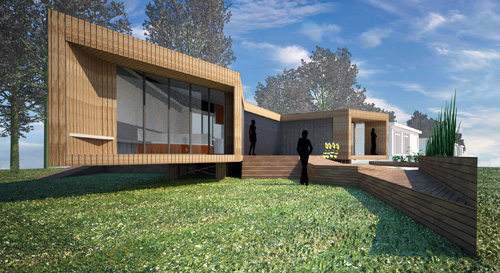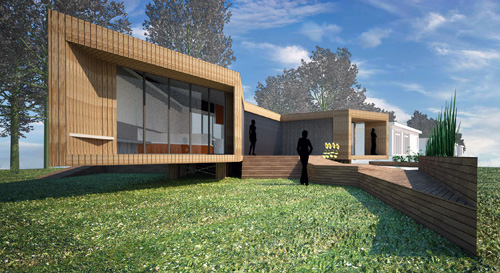 The Refract team recycled used billboards to create waterproof walls for the home.Courtesy Santa Clara University
The Refract team recycled used billboards to create waterproof walls for the home.Courtesy Santa Clara University
Adjacent to a three-story parking garage on the Silicon Valley campus of Santa Clara University, workers are busy building a contemporary wood-clad home that wouldn’t look out of place in the pages of Dwell or another shelter magazine for the po-mo, Tesla-driving, little-square-eyeglasses-wearing set.
Which is exactly the idea.
The home is California’s entry into the U.S. Department of Energy’s biannual Solar Decathlon and is a collaboration between undergraduates at Santa Clara University and the California College of the Arts in San Francisco. Twenty university teams are competing, and the winner, according to the Energy Department, will be the one whose design and engineering “best blends aesthetics and modern conveniences with maximum energy production and optimal efficiency.”
“Most of the homes in the competition are boxes,” Preet Anand, a senior majoring in engineering physics, says above the din of hammers on a sweltering afternoon. “A box is very efficient but the problem is that it doesn’t embrace its environment.”
“Our target market is Los Gatos,” he adds, referring to an upscale Silicon Valley town nestled in the foothills of the Santa Cruz Mountains. “It’s not a very green area but it’s a very trendy area. People in Los Gatos have the financial means to afford a house like this.”
 A conceptual drawing of the Refract House.In other words, style counts. In the 2007 Solar Decathlon, Santa Clara came in third, scoring high for technology but low on esthetics as evidenced by the boxy bungalow — more tract home then trendy — that now sits around the corner from the ’09 model under construction.
A conceptual drawing of the Refract House.In other words, style counts. In the 2007 Solar Decathlon, Santa Clara came in third, scoring high for technology but low on esthetics as evidenced by the boxy bungalow — more tract home then trendy — that now sits around the corner from the ’09 model under construction.
Called the Refract House, it’s shaped like a bent tube, wrapped around a deck and reflecting pool. The home is packed with green technology designed to be unobtrusive. It doesn’t scream green, it just is.
Sort of like the Refract team. The environmental values are baked in and it takes some prodding to get Anand and project manager Allison Kopf — a junior also majoring in engineering physics – to talk about the save-the-world aspect of the endeavor that has consumed the past two years of their lives.
Rather, they approach the contest in typical Silicon Valley fashion — as a startup. And that’s a good thing. As they enter the workforce in this epicenter of innovation, the members of Generation Green view sustainability as a basic business value.
“We’re in Silicon Valley so we get the opportunity to take advantage of all the crazy technology because we have all the startup companies that are doing the most wild things and just have got funding and are open to working with you to get their technology out there,” says Kopf, 20. “We’re in a green revolution and we need as engineering students to take that on.”
Among the companies collaborating with Team California, as the joint venture between Santa Clara University and the California College of the Arts is called — are solar panel maker SunPower, solar equipment maker Applied Materials and Seattle-area bamboo wood company Teragren.
“The project is kind of a startup training 101,” says Anand. “We wear so many hats. Allison first started helping with the solar loads and then changed to doing solar panel calculation. I was the head designer for the water systems in the house but help out with fundraising and with digital communication.”
In fact, after graduation the core members of the 2007 contest team founded their own green tech startup, which remains in stealth mode.
Preet, 21, and Kopf give me a tour of the 800-square-foot, one-bedroom Refract House, the product of a 30-member team that typically spends 50 to 60 hours a week on the project.
The roof sports a massive 11.2-kilowatt solar array. That will produce about 11 times the electricity necessary to power a home of this size. But part of the contest brief is to generate as much power as possible from 800-square feet. The team also needed the extra juice for the radiant heat, hot water and cooling systems.
 The house features a large number of windows to minimize the need for electrical lighting during daylight hours.Courtesy Santa Clara UniversityThe house faces south to maximize solar energy production, so the team installed triple-paned argon gas-filled windows to keep the interior cool in the summer sun. A weather-tracking gray-water system is used for irrigation and rainwater is harvested for the reflecting pool. The home’s insulation is vegetable oil-based and the house has been weatherized with old highway billboards that clad the exterior under the wood siding. The kitchen appliances are high efficiency and the lighting is LED.
The house features a large number of windows to minimize the need for electrical lighting during daylight hours.Courtesy Santa Clara UniversityThe house faces south to maximize solar energy production, so the team installed triple-paned argon gas-filled windows to keep the interior cool in the summer sun. A weather-tracking gray-water system is used for irrigation and rainwater is harvested for the reflecting pool. The home’s insulation is vegetable oil-based and the house has been weatherized with old highway billboards that clad the exterior under the wood siding. The kitchen appliances are high efficiency and the lighting is LED.
“We measure everything — from how much hot water your shower is using to how much energy the house is producing to how much energy you’re consuming room by room. This is all available in real time on a display,” says Anand.
And there’s an iPhone app, of course, to let the homeowner monitor that data and turn off lights and appliances by remote control. Forget to close a window before you left for that business trip to New York? No worries. Some of the windows are mechanical and can be operated from your iPhone.
So what does all this cost? Minus the extra solar wattage on the roof and the structural steel — installed so the Refract House can be transported to Washington, D.C., for the Decathlon judging in October — Anand and Kopf say the sale price would be around $440,000. That’s minus the land.
The Refract House experience already has changed the duo’s post-graduation plans. Both switched to majors more conductive to careers in green tech. Anand would like to work for one of the big international consulting firms involved in green projects like Masdar City in Abu Dhabi while Kopf wants to go into green tech or green policy.
“I’m looking at grad schools in Germany because they’re the leaders in solar right now,” she says.
In the meantime, they want to win the Solar Decathlon. The house will be finished by Sept. 1, when it will be opened to the public for tours for a few days before being dissembled and shipped to Washington.
—
Videos features about the Refract House:


